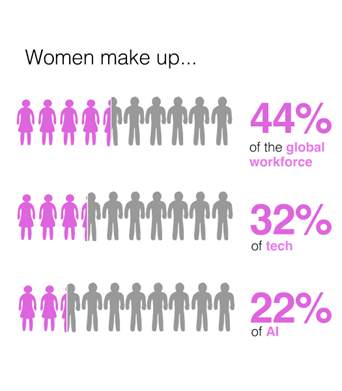Where are all the Women in AI?

By Fiona Passantino, Founder of Executive Storylines
AI is one of the world’s fastest growing industries in 2024, predicted to grow 38% until 2030 . There’s huge demand for AI applications; not just for desktop productivity, but all our many, interconnected things; our smart appliances, digital assistants and self-driving vehicles. This brings the need for a highly-skilled, dedicated workforce; one that can represent the full range of real-life consumer use cases.
About 44% of the total global workforce is female . The tech industry, famously male-dominated, has a 32% female population, down from 35% in 1984 . Within tech, AI shows even more extreme numbers; only 22% of the employees are female . Women who find their way into AI often don’t stay; they are 1.5 times more likely to lose their job to automation and reorganisation than men .
In a field as exciting and explosive as AI, where are all the women? Like many things, the imbalance is due to a complex combination of societal, educational and workplace forces.

WE EXAMINE A FEW REASONS FOR THE IMBALANCE.
- Priming the Pipeline
The journey into a career in AI often begins with the study of STEM subjects (Science, Technology, Engineering and Mathematics). These are traditionally fields with fewer women pursuing degrees, resulting in a smaller pipeline of women with this qualification entering the workforce.
Why do women avoid this line of study? Again, it’s a puzzle; a lack of encouragement and support for girls to pursue STEM studies by their peers, mentors, teachers and career counsellors. Even the parents of girls often advise girls away from jobs in tech and AI.
Educators and mentors point to the “burnout” culture of the industry; young women are told that they cannot combine AI jobs with parenting, nor enjoy a balanced life if they pursue STEM subjects. AI, like so many of the tech roles, are seen as subjects for boys.
- Hiring and Firing Bias
Hiring studies reveal that we hire the applicants with whom we more closely identify; men hire other men to fill roles in AI development, largely unaware of these biases. They affect hiring, promotion, and venture capital funding decisions. The result is that women suffer an additional disadvantage both in the hiring and entrepreneurial realms.
Once on the job, women often leave. Of those who left the field to pursue careers elsewhere, 58% of them did so due to the gender bias they felt in the workplace[i].
- Lack of Role Models and Mentors
Having fewer experienced women in AI means there are fewer role models and mentors for other women starting out. Role models guide, inspire and support newcomers, coaxing them to expand into adjacent areas of work or seek more powerful roles. Having fewer of these guides further perpetuates the cycle of underrepresentation and lessens the support they enjoy.
Women in male-dominated fields often report feeling like they don't belong, that they’re not “part of the club”, or are not good enough, a state of mind we call the “imposter syndrome”. This feeling is exacerbated when women are in the minority. This can often turn into a confidence gap; women might be less likely to apply for certain roles or promotions.
- Unfriendly Culture
Many point to the macho culture of AI, the “move fast and break things” culture of Silicon Valley, the race towards Artificial General Intelligence (AGI). AI is the domain of “bitcoin bros” and “Discord dudes”.
The men behind some of the AI breakthroughs are celebrated as pioneers, rebels and trailblazers, while the women in the field making significant contributions are often overlooked. The superstar male CEOs such as Sam Altman of OpenAI, Elon Musk of xAI or Suleman of Google are widely celebrated, sending a discouraging message to aspiring female developers.

BRINGING BALANCE TO AI
AI struggles with pay imbalances, gender discrimination and a lack of work-life balance. But the tech fields have been among the most flexible and free in terms of remote and non-structured hours when compared with traditional industries. Tech and AI were hybrid way before the pandemic forced everyone else to rethink their workplace structures.
Deloitte’s 2023 State of AI report concludes that having more women in AI improves overall system design and functionality. Of those surveyed, 71% say expanding women’s role in AI brings perspectives needed in the industry[i]. At the same time, 63% point out that machine learning would always produce biased results as long as it’s a male-dominated field[ii].
As AI evolves, women’s perspective and skillset are needed to guide it in a way that benefits as many people as possible. Diversity in this field isn’t just about fairness, but a strategic necessity. And, given the risks and inevitability of Artificial General Intelligence (AGI), a Human imperative to get it right.
ABOUT THE AUTHOR
Communication, culture and employee engagement expert, Fiona helps Humans with AI Integration so they are empowered to take on the future. She is a speaker, trainer, facilitator and executive coach and the author of the upcoming "AI-Powered Professional" and the "Comic Books for Executives" series.
Visit www.storylnz.com or reach out to Fiona on LinkedIn: https://www.linkedin.com/in/fionapassantino/

Fiona Passantino
[1] Howarth (2024) “57 NEW AI Statistics” Exploding Topics. Accessed February 14, 2024 https://explodingtopics.com/blog/ai-statistics
[1] UN HR Portal (2024) “What percentage of men and women is the United Nations global workforce made up of?” United Nations HR Portal. Accessed February 14, 2024. https://hr.un.org/poll/what-percentage-men-and-women-united-nations-global-workforce-made
[1] Dean (2023) “60+ Women in Tech Statistics You Need to Know in 2023 – Closing the Gaps” Techopedia. Accessed February 14, 2024. https://www.techopedia.com/women-in-tech-statistics
[1] Deloitte (2024) “Women in AI”[1] Deloitte AI Institute, AWS. Accessed January 25, 2024. https://www2.deloitte.com/us/en/pages/consulting/articles/state-of-women-in-ai-today.html
[1] McKinsey Global Institute (2023) “Generative AI and the future of work in America” McKinsey Global Institute https://www.mckinsey.com/mgi/our-research/generative-ai-and-the-future-of-work-in-america
[1] Deloitte (2023) “Fewer women work in AI. More of them are leaving. See the problem?” Deloitte https://action.deloitte.com/insight/3443/fewer-women-work-in-ai-more-of-them-are-leaving-see-the-problem
[1] Deloitte (2024) “Women in AI”[1] Deloitte AI Institute, AWS. Accessed January 25, 2024. https://www2.deloitte.com/us/en/pages/consulting/articles/state-of-women-in-ai-today.html
[1] Women in Tech (2023) “Why are there so few women in Artificial Intelligence (AI)?” Women in Tech website. Accessed January 25, 2024. https://www.womenintech.co.uk/why-are-there-so-few-women-in-artificial-intelligence-ai/


